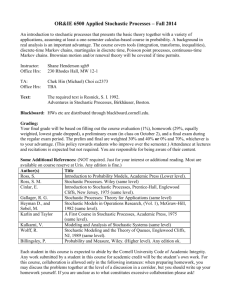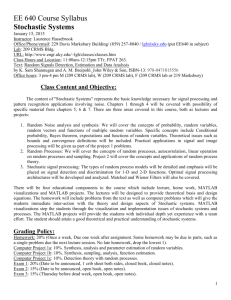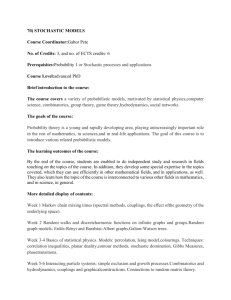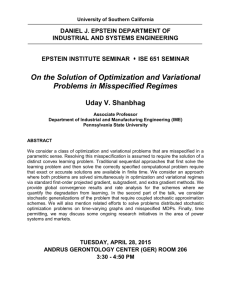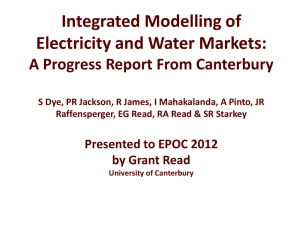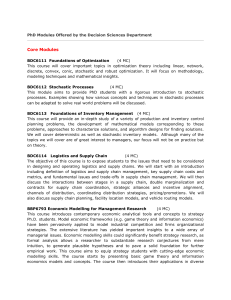Example
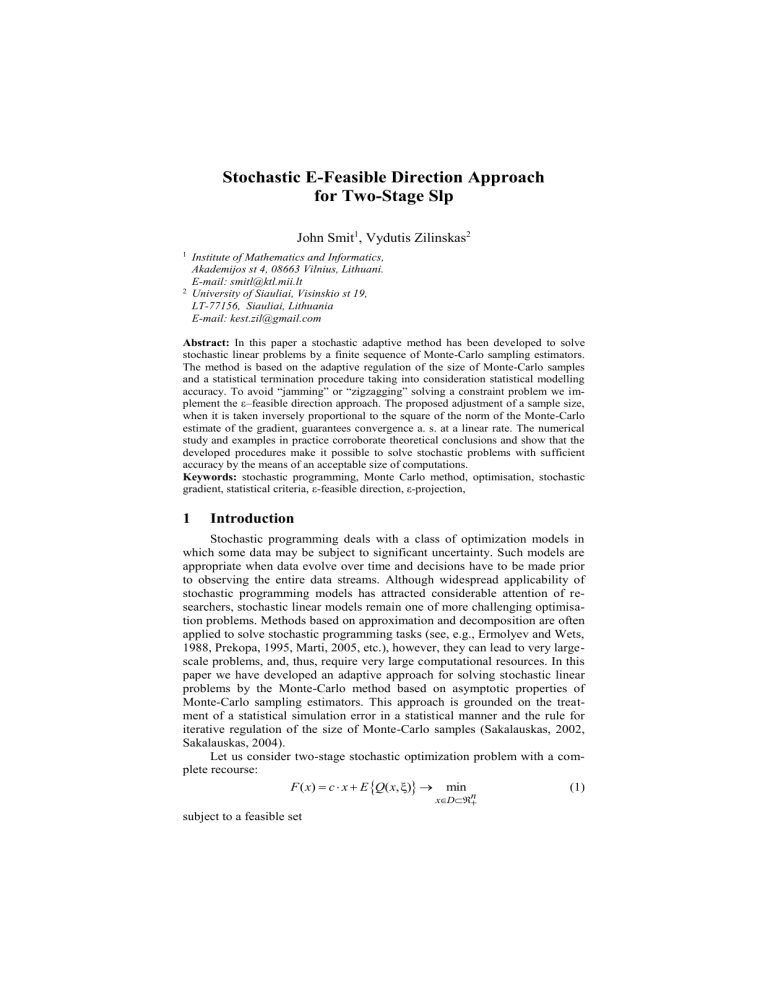
Stochastic Ε-Feasible Direction Approach for Two-Stage Slp
John Smit
1
, Vydutis Zilinskas
2
1 Institute of Mathematics and Informatics,
Akademijos st 4, 08663 Vilnius, Lithuani.
E-mail: smitl@ktl.mii.lt
2 University of Siauliai, Visinskio st 19,
LT-77156, Siauliai, Lithuania
E-mail: kest.zil@gmail.com
Abstract: In this paper a stochastic adaptive method has been developed to solve stochastic linear problems by a finite sequence of Monte-Carlo sampling estimators.
The method is based on the adaptive regulation of the size of Monte-Carlo samples and a statistical termination procedure taking into consideration statistical modelling accuracy. To avoid “jamming” or “zigzagging” solving a constraint problem we implement the ε–feasible direction approach. The proposed adjustment of a sample size, when it is taken inversely proportional to the square of the norm of the Monte-Carlo estimate of the gradient, guarantees convergence a. s. at a linear rate. The numerical study and examples in practice corroborate theoretical conclusions and show that the developed procedures make it possible to solve stochastic problems with sufficient accuracy by the means of an acceptable size of computations.
Keywords: stochastic programming, Monte Carlo method, optimisation, stochastic gradient, statistical criteria, ε-feasible direction, ε-projection,
1 Introduction
Stochastic programming deals with a class of optimization models in which some data may be subject to significant uncertainty. Such models are appropriate when data evolve over time and decisions have to be made prior to observing the entire data streams. Although widespread applicability of stochastic programming models has attracted considerable attention of researchers, stochastic linear models remain one of more challenging optimisation problems. Methods based on approximation and decomposition are often applied to solve stochastic programming tasks (see, e.g., Ermolyev and Wets,
1988, Prekopa, 1995, Marti, 2005, etc.), however, they can lead to very largescale problems, and, thus, require very large computational resources. In this paper we have developed an adaptive approach for solving stochastic linear problems by the Monte-Carlo method based on asymptotic properties of
Monte-Carlo sampling estimators. This approach is grounded on the treatment of a statistical simulation error in a statistical manner and the rule for iterative regulation of the size of Monte-Carlo samples (Sakalauskas, 2002,
Sakalauskas, 2004).
Let us consider two-stage stochastic optimization problem with a complete recourse:
( )
( , )
min (1) x D subject to a feasible set
D
,
n
(2) where
Q ( x ,
)
min y
[ q
y | W
y
T
x
h , y
R m
] (3) vectors b , q , h and full rank matrices A , W, T are of appropriate dimensionality. (See details in Sakalauskas, L, and Zilinskas, K, (2006a)).
2. Stochastic differentiation and Monte-Carlo estimators
In this section we discuss some basic ideas applied in stochastic gradient search in two-stage programming with recourse. Here we assume that
Monte-Carlo samples Y
( y y
2
,..., y
N
), of a certain size N are provided for any x
D , where tributed at density i y are independent random variables identically disp ( x ,
).
Then the sampling estimator
~
F ( x ) and the sam-
pling standard deviation f ( x , y
1
), f ( x , y
2
), ..., f ( x ,
~
D ( x ) can be computed from the random sample : y
N
)
. Next, assume the stochastic gradient g ( x , y j
) can be computed for any x
D and any y j
, where
Eg ( x , y j
)
F ( x ) , j
1 , N . Thus the corresponding sampling gradient estimator
be estimated, too:
1
N
N j
1 g x y j
) , and the sampling covariance matrix can
1
N
n
N j
1 g x y j
)
G
g x y j
)
G ) ' (9)
Let us consider the analytical approach (AA) to estimate (9) two-stage stochastic programming with recourse (1). Indeed, by the duality of linear programming we have that
( )
E
max u
(
|
T
0, u
. (10)
Further it can be derived that under the assumption on the existence of a solution to the second stage problem in (3) and continuity of the measure P , the objective function is smoothly differentiable and its gradient is expressed as
x
( )
i
, where g
1
*
(11) is given by a set of solutions of a dual problem
( h
T
x )
T u
* max u
[( h
T
x )
T u | u
W
T q
0 , u
m
] , (12)
(details are given in Rubinstein and Shapiro, 1993, Shapiro, 2000, etc.).
...
Table 1. Requiring Monte-Carlo sample size by the number of variables
Number of variables
10
20
40
Monte-Carlo sample size
500
1000
2200
60
80
100
3300
4500
6000
Results of studying Example 2: dependence (1
) on the confidence
and the distance to the optimal point r is represented in Figs. 1–4. r=0.002
1
0,8
0,6
0,4
0,2
NN= 200
NN= 1000
NN= 5000
0
0 0,2 0,4 0,6 0,8 1
α
Fig. 1. (1
)
by the confidence
, the distance r
0.002
r=0.01
1
0,8
0,6
0,4
NN= 500
NN= 1000
NN= 2000
0,2
0
0 0,2 0,4 0,6 0,8 1
α
Fig. 2.
(1
) by the confidence
, the distance r
0.005
3 Conclusions
Thus, the stochastic iterative method has been developed to solve stochastic linear programming (SLP) problems by a finite sequence of Monte-
Carlo sampling estimators. The proposed method was studied by numerical ways using the examples taken from literature and standard database of two stage programming tests.
The approach presented in this paper is grounded on the stopping procedure and the rule for adaptive regulation of the size of Monte-Carlo samples, taking into account statistical modelling accuracy. Several stochastic gradient estimators were compared by computer simulation studying the workability of the estimators for testing the optimality hypothesis by statistical criteria. It was demonstrated that a minimal size of the Monte Carlo sample necessary to approximate the distribution of the Hotelling statistics, computed using gradient estimators, by the Fisher distribution depends on an approximation approach and dimensionality of the task n . The computation results show that an analytical and difference approach provide estimators for reliable checking of the optimality hypothesis in a wide range of dimensionality of the stochastic optimization problem ( 2
n
100 ).The proposed termination procedure allows us to test the optimality hypothesis and to evaluate reliably confidence intervals of objective and constraint functions in a statistical way.
The regulation of a sample size in case this size is taken inversely proportional to the square of the norm of the gradient of the Monte-Carlo estimator allows us to solve SLP problems rationally from a computational viewpoint and guarantees convergence a. s. In our approach optimization can usually require only several times more computations as compared with the computation of one function value. The numerical study corroborates theoretical conclusions on the convergence method and shows that the developed procedures make it possible to solve stochastic problems with sufficiently agreeable accuracy by the means of an acceptable amount of computations.
All test examples taken from standard database were solved successfully and some solutions given on this base were improved.
References
Bertsekas, D. P. 1982. Constrained Optimization and Lagrange Multiplier Methods .
Academic Press, New York, London.
Ermolyev, Yu., and Wets, R. 1988. Numerical Techniques for Stochastic Optimization . Springer-Verlag, Berlin.
Marti, K. 1996. Differentiation formulas for probability functions: The transformation method, Mathematical Programming 75(2): 201–220.
Marti, K. 2005. Stochastic Optimization Methods . Springer: N.Y.
Prekopa, A. 1995. Stochastic Programming . Kluwer.
Rubinstein, R, and Shapiro, A. 1993.
Discrete events systems: sensitivity analysis and stochastic optimization by the score function method . Wiley & Sons, N.Y.

